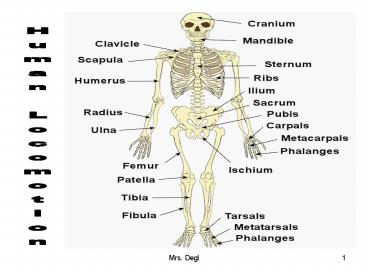Human Locomotion - PowerPoint PPT Presentation
1 / 9
Title:
Human Locomotion
Description:
Mrs. Degl Locomotion or movement involves the interaction of bones, cartilage, muscles, tendons, and ligaments. Bones: Bones are made of bone tissue and are hard and ... – PowerPoint PPT presentation
Number of Views:1318
Avg rating:3.0/5.0
Title: Human Locomotion
1
Human Locomotion
2
Locomotion or movement involves the interaction
of bones, cartilage, muscles, tendons, and
ligaments.
- Bones
- Bones are made of bone tissue and are hard and
rigid. - They provide support and protection for the soft
parts of the body. - They are the sites for muscle attachment.
- At joints, bones act as levers, letting the body
move when muscles contract. - Long bones have marrow that create new red and
white blood cells.
3
- Cartilage
- Cartilage is a type of flexible, fibrous, elastic
connective tissue. - Babies are born with more cartridge than bones.
This cartridge gradually hardens into bone. - An adult nose, trachea, and ears are still mostly
cartridge. - Cartridge also provides cushions at joints.
- Joints
- Joints are locations where bones attach to each
other. - Hinge joints move back and forth and allow the
elbow and knee to bend. - Ball-and-socket joints are capable of circular
movement and allow the shoulder and hip to move. - The neck has a pivot joint that can move in a
half circle. - The skull is made of immovable joints.
4
Muscles
- Muscles can contract
- Muscle is also a tissue
- All movement in the body involves muscles
- There are 3 types of human muscle tissue
- Skeletal Muscle
- Smooth Muscle
- Cardiac Muscle
5
Skeletal Muscle
Skeletal Muscle is voluntary muscle that attaches
to the bones of the skeleton.
- They are also called striated muscles.
- Skeletal muscles appear striated (striped).
- Skeletal muscles movements are controlled by the
nervous system, which makes controlled movements
possible. - Triceps and biceps usually make opposite
movements (when one contracts the other relaxes).
6
Smooth Muscle
- Smooth muscle is not striated.
- Smooth muscle is also called visceral muscle.
- Smooth muscle is found in the walls of the
digestive organs and arteries as well as other
internal organs. - Smooth muscles are not under voluntary control.
They are involuntary.
7
Cardiac Muscle
- The cardiac tissue found only in the heart.
- This muscle is not under voluntary control.
- It is very different than skeletal muscle.
8
Tendons and Ligaments
- Tendons attach muscles to bone.
- Ligaments attach bones to other bones.
9
Disorders of the Locomotive System
- Arthritis is an inflammation of joints, which can
be very painful and make movement difficult. - Tendonitis is an inflammation of a tendon,
usually where it is attached to the bone. This
occurs often in athletes and people who use the
same tendons over and over again.































